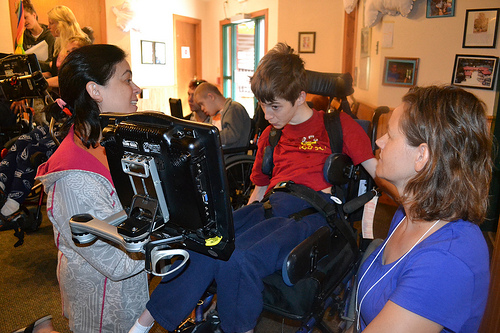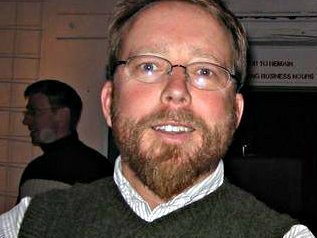

The 30-some kids here this week all use “adaptive speech technology,” or what they call “talkers.” They’re computers that allow people who can’t speak to vocalize.
“These kids have a lot to say,” says Joyanne McShea, a speech language pathologist at Children’s Hospital Colorado who’s working at the camp. “I think sometimes when we look at them we don’t realize how much they have going on in their minds, and so giving them these tools opens up the world for them, and they’re able to relate with people and experience life.“
McShea is working with Angel Krautschun from Colorado Springs. Angel is 10 years old, with curious, searching eyes and bright pink shoelaces. She’s in a wheelchair because cerebral palsy makes it hard for her to control her arms and legs. Angel is also legally blind, but she can see enough to be able to use the computer mounted on her chair to spell out words that the machine can then say for her.
It looks like a painstaking process for Angel to spell out even simple words. But digital talkers like hers can also be programmed to call up phrases she uses a lot, at the push of a button.
“My name is Angel Krautschen,” her talker says. “I’m 10 years old. My birthday is on August first.”
Talking with Technology Camp isn’t just for kids. There are as many speech language pathologists here as kids. They’re learning to use the many different kinds of talkers out there, and at the same time helping kids learn to use them better.
Jill Tullman from Denver is an experienced speech language pathologist who’s teaching both kids and newer therapists, like Mendi Carrol. Tullman shows Carrol and 20-year-old camper Bryce Vernon, who’s in a wheelchair and uses a talker, how to program the machine to generate one of several different goodbyes randomly when he pushes one button.
Bryce programs the talker to say, “bye, later, later dude, see ya” and ”I’m out of here.”
Bryce is a film student at a college in Los Angeles. Because he can’t control his hands very well, he uses his eyes to type and press buttons on the computer. His talker has a camera mounted in front of him that tracks his eye movements, allowing him to move a red dot on the talker’s screen to a letter or key, and hold it there for a split second to type.
It’s amazing technology, but it also looks very taxing for Bryce.
“Tiring,” Bryce says when I ask what it’s like using his talker. “It is helpful and tiring.”
Tiring as it is, Bryce works hard on mastering his talker. His only other means of communicating is by moving his head up to say yes, or shaking it to say no. Just how limiting that is, and how liberating a talker can be, becomes evident a few minutes into our meeting, when we’re all looking at his talker, and Bryce sees something we don’t.
“Bee,” Bryce says. “There’s a bee.”
Jill thanks him for letting us know, and Mendi quickly swats the insect. A bee could be a big deal for someone who doesn’t have the ability to shoo it away or move away from it.
Bryce is able to tell me a lot about himself with his talker. The device is also email capable, and he can call up recorded music on it, too. He demonstrates by playing me a classic jazz song.
But the interview is clearly exhausting for him. At the end, I ask Bryce if there’s anything he wants people to know about him.
“Never, ever give up,” he says.








